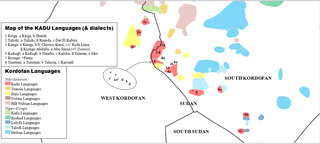Related Research Articles

The West Atlantic languages of West Africa are a major subgroup of the Niger–Congo languages.
The Southern Nilotic languages are spoken mainly in western Kenya and northern Tanzania. They form a division of the larger Nilotic language family, along with the Western Nilotic languages and the Eastern Nilotic languages.

In most classifications, the Eastern Sudanic languages are a group of nine families of languages that may constitute a branch of the Nilo-Saharan language family. Eastern Sudanic languages are spoken from southern Egypt to northern Tanzania.

The Kadu languages, also known as Kadugli–Krongo or Tumtum, are a small language family of the Kordofanian geographic grouping, once included in Niger–Congo. However, since Thilo Schadeberg (1981), Kadu is widely seen as Nilo-Saharan. Evidence for a Niger-Congo affiliation is rejected, and a Nilo-Saharan relationship is controversial. A conservative classification would treat the Kadu languages as an independent family.
The Khoi languages are the largest of the non-Bantu language families indigenous to Southern Africa. They were once considered to be a branch of a Khoisan language family, and were known as Central Khoisan in that scenario. Though Khoisan is now rejected as a family, the name is retained as a term of convenience.
The North Omotic (Nomotic) or Ta-Ne Omotic languages, belong to the Omotic branch of the Afro-Asiatic family and are spoken in Ethiopia.
The Ubangian languages form a diverse linkage of some seventy languages centered on the Central African Republic. They are the predominant languages of the CAR, spoken by 2–3 million people, and include the national language, Sango. They are also spoken in Cameroon, Chad, the DR Congo, and South Sudan.
The Bambukica.k.a.Trans-Benue or Yungur–Jen languages form a proposed branch of the provisional Savanna languages, a reduced form of the Waja–Jen branch of the old Adamawa languages family. They are spoken in north eastern Nigeria. Their unity is not accepted by Güldemann (2018).
The Bongo–Bagirmi or Sara–Bongo–Bagirmi languages are the major branch of the Central Sudanic language family with about forty languages. Principal groups include Bagirmi languages such as Naba and the Sara languages. They are spoken across CAR, Chad, South Sudan, and adjacent countries.
Lunguda (Nʋngʋra) is a Niger–Congo language of Nigeria. They settle western part of Gongola mainly in and around the hills of the volcanic Lunguda Plateau, Adamawa state. Joseph Greenberg counted it as a distinct branch, G10, of the Adamawa family. When Blench (2008) broke up Adamawa, Lunguda was made a branch of the Bambukic languages.
The Tula–Waja, or Tula–Wiyaa languages are a branch of the provisional Savanna languages, closest to Kam (Nyingwom), spoken in northeastern Nigeria. They are spoken primarily in southeastern Gombe State and other neighbouring states.
The Leko languages are a small group of languages spoken in northern Cameroon and eastern Nigeria. They were labeled "G2" in Joseph Greenberg's Adamawa language-family proposal. The Duru languages are frequently classified with the Leko languages, although their relationship remains to be demonstrated.
The Mumuye–Yendang languages are a proposed group of Savanna languages spoken in eastern Nigeria. They were labeled "G5" in Joseph Greenberg's Adamawa language-family proposal.
The Duru languages are a group of Savanna languages spoken in northern Cameroon and eastern Nigeria. They were labeled "G4" in Joseph Greenberg's Adamawa language-family proposal.
Siamou, also known as Sɛmɛ (Seme), is a language spoken mainly in Burkina Faso. It is unclassified within the proposed Niger–Congo language family and could likely be a language isolate
Baka is a dialect cluster of Ubangian languages spoken by the Baka Pygmies of Cameroon and Gabon. The people are ethnically close to the Aka, the two together called the Mbenga (Bambenga), but the languages are not related, apart from some vocabulary dealing with the forest economy, which suggests the Aka may have shifted to Bantu, probably 15000 people have shifted.
The Mbaka or Bwaka language, Ngbaka Ma'bo is a major Ubangian language spoken by the Mbaka people of CAR and Congo.
The Limba language, Hulimba, is a Niger-Congo language of Sierra Leone and Guinea. It is not closely related to other languages and appears to form its own branch of the Niger–Congo family, although it was formerly classified as an Atlantic language. Dialects include Tonko, Sela, Kamuke, Wara-wara, Keleng, Biriwa, and Safroko. The eastern variety, spoken primarily in Guinea, is quite distinct. Limba has a system of noun classes, marked by an old, eroded set of prefixes augmented by a newer set of enclitics.
The Yobe ([]) language is an unclassified Niger-Congo language of Benin and Togo.
The Bikwin–Jen or simply the Jen languages form a branch of the Adamawa family. They are spoken in and around Karim Lamido LGA in Taraba State, and in other nearby states of eastern Nigeria.
References
- ↑ Güldemann, Tom (2018). "Historical linguistics and genealogical language classification in Africa". In Güldemann, Tom (ed.). The Languages and Linguistics of Africa. The World of Linguistics series. Vol. 11. Berlin: De Gruyter Mouton. pp. 58–444. doi:10.1515/9783110421668-002. ISBN 978-3-11-042606-9. S2CID 133888593.
- ↑ Winkhart, Benedikt. 2015. The reconstruction of Mundu-Baka. Berlin: Humboldt-Universität zu Berlin MA thesis.